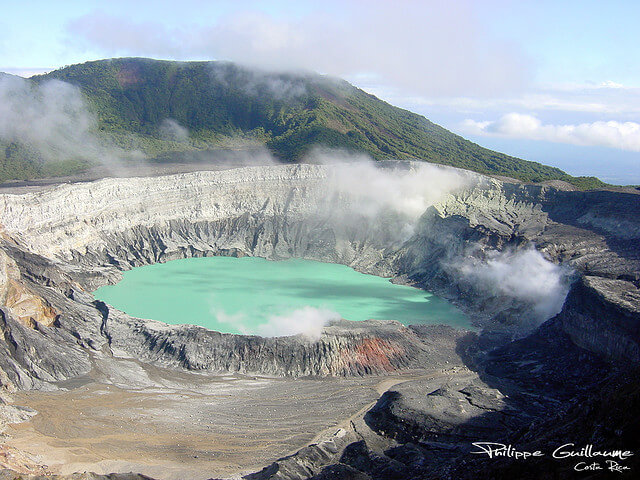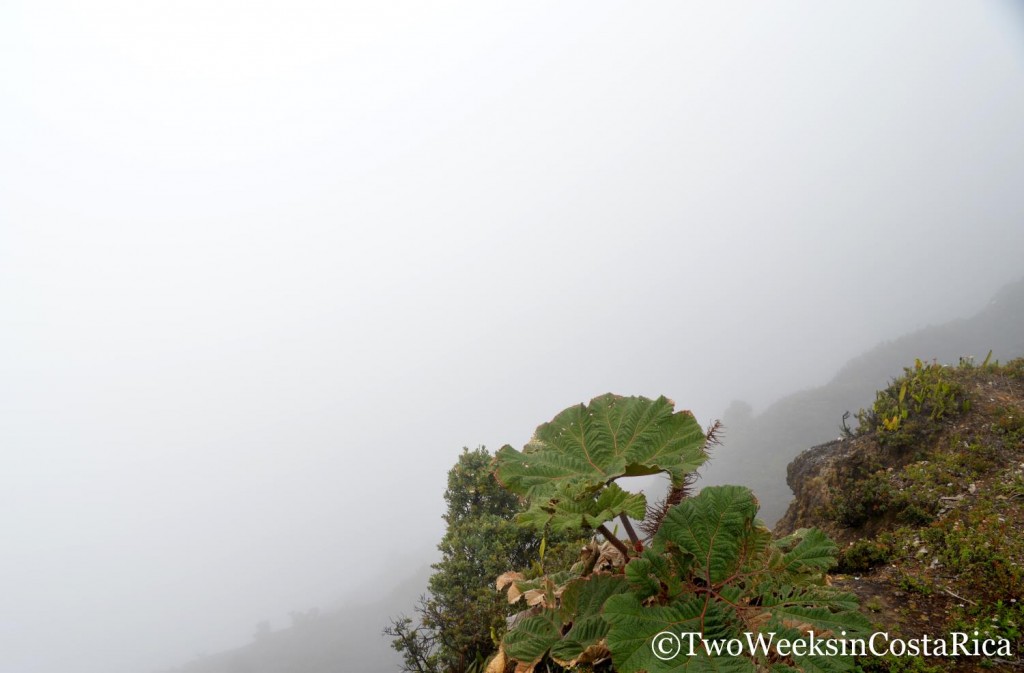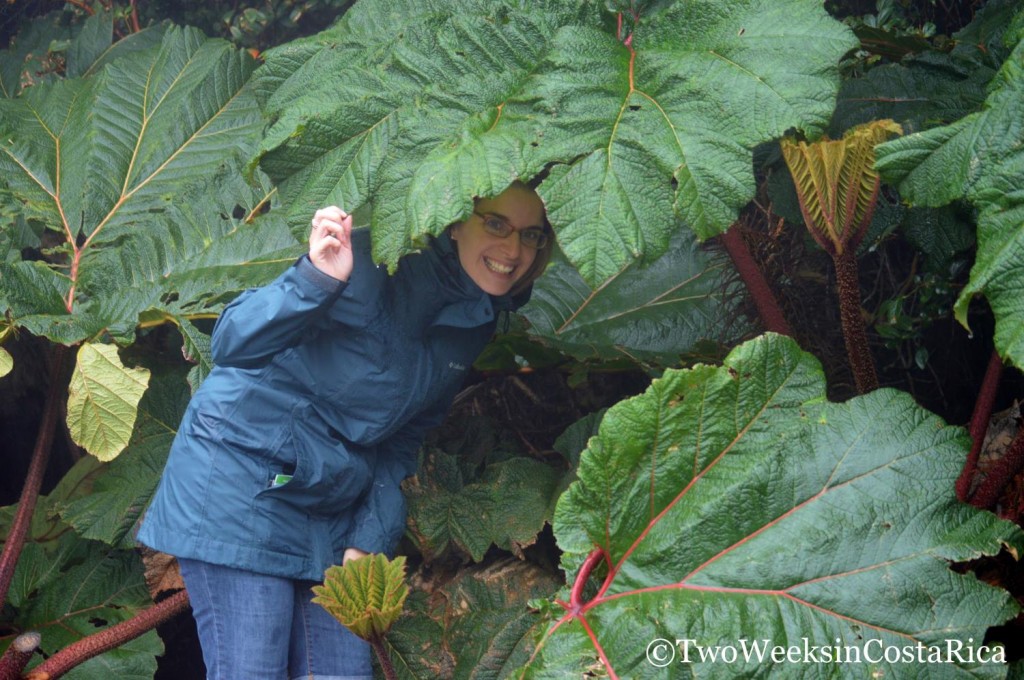Even before moving to Costa Rica, we had wanted to visit Poas volcano. Considered to be the largest active crater in the world at almost a mile (1.5 kilometers) wide and 300 meters (900 feet) deep, Poas is an icon in Costa Rica. Part of the reason for its popularity is its location. Poas is close to San Jose and the international airport, making it an easy day trip on either end of a vacation. But Poas is a must-see in its own right. The crater lake is one of the most acidic in the world, having a pH of around zero. This makes the lake very toxic but also gives it an intense blue color. The striking pictures of Poas’ aquamarine water and fascinating geology were enough to make us want to visit, but then, to intrigue us even more, in early 2017, the volcano ejected a dense plume of mud and steam 300 meters (984 feet) into the air.
While living on Lake Arenal, we took a road trip to the Puerto Viejo de Sarapiqui region and knew we had to fit in a visit to nearby Poas. Unfortunately, we can’t say that it was everything we dreamed it would be (keep reading to find out why), but we picked up some good tips along the way.

We arrived at Vara Blanca in the mid-afternoon. This small, mountain town in the foothills of Poas volcano is about an hour’s drive from San Jose and took us a little more than two hours from La Fortuna. Since we were visiting in August during Costa Rica’s rainy season, we were delighted that it was a fairly sunny day. Our original plan was to visit the national park first thing the next morning and get a good view of the crater before any clouds developed. But seeing that the sun was out once we arrived, we quickly changed course and headed straight for the park entrance, thinking that tomorrow could be worse.
After climbing the steep hill in our car and catching some awesome views of the Central Valley below, we reached the park entrance. At the gate, there was a line of about ten cars waiting to get through. We started to worry at this point because the clouds were beginning to build. Five minutes later, we had paid our entrance fee ($15), parked the car, and were practically sprinting up the paved trail to the edge of the crater. As we got closer, it started to drizzle. Closer yet and we could smell the sulfur from the volcano in front of us. And as we reached the viewing platform, there she was, in all her glory.

It took us a while to absorb the fact that we weren’t going to see the crater. We took turns being overly optimistic that a sudden breeze would lift the fog, but after about 15 minutes and increasing rain, we succumbed to defeat.
Something that we have learned by living in Costa Rica though is that no day is a waste. With our raincoats zipped, we walked some of the trails nearby. Before long we had spotted a species of bird found only in this type of cloud forest called the Large-footed Finch. Since we have become official birding geeks since moving to Costa Rica, this was pretty cool to us. The pair was hopping around, turning over wet leaves on the ground with their oversized feet, searching for food. We also saw some colorful Variegated Squirrels eating and stashing acorns in the nearby trees.

When it really started to rain, we took shelter in the park headquarters and perused the small museum (good for kids) and gift shop. Since it was the weekend, dozens of local families were around, enjoying a picnic and just relaxing. Family time, especially on Sundays, is an important part of Costa Rica’s culture and everyone was still having a great time, regardless of the weather.

The next day the weather was still cloudy so we explored more of Vara Blanca and the area around Poas. We found that even without a good view of the toxic volcanic lake, the Poas area was well worth a visit. Still, we were disappointed to have not seen the crater, so wanted to provide some tips for those of you planning a visit.
Tips for Visiting (and Actually Seeing) Poas Volcano
- Go During the Dry Season (December to April)– Poas is known for being clouded over due to converging winds from the Pacific and Caribbean slopes and for this reason people advise to visit during the dry season. Is it possible to see it during the rainy season? Sure it is but there are no guarantees. If you’re coming during the rainy months, increase your chances by giving yourself a couple of extra days in the area and race to the volcano on the first clear one. Even if it’s not clear when you get there, stick around because subtle shifts in the wind are known to lift the clouds.
- Get to the Park Early– Cloud cover increases as the day goes on so everyone suggests getting to the park early. Ironically, we discovered that the park actually doesn’t open until 8 a.m.—go figure! Still the best thing you can do is to get in line before they open the gates, not only for the clouds but to avoid the crowds. Poas National Park is one of the busiest parks in Costa Rica so by arriving early, you’ll miss the mid-morning influx of tour buses, vans, and cars too.
- Visit the Crater First, Hike Second– Although the park has some “trails,” you don’t really hike up to the volcano; it’s more of a leisurely walk. The main trail from the parking lot is a wide, paved avenue that is great for people with disabilities (even wheel chairs), kids, and tourists who might have had too many Imperials the night before. If you do want to explore the few other trails within the park, make sure to visit the crater first then do some hiking while the crowds fill in.
- Bring a Jacket– Even if it doesn’t rain during your visit, sometimes it can be cool at the top of the volcano. Poas sits about 2,700 meters (8,000 feet) above sea level so at that altitude, you’re almost certain to feel a chill.
- Pack a Cooler– The weather wasn’t picnic-worthy when we visited, but the park has some great areas to hang out if you want to spend the day (with tables, bathroom facilities, etc.). They also have an on-site cafeteria. If you just want to see the crater, you could easily be in and out within 30 minutes, but we recommend hanging around for a bit longer. At Poas’ elevation, in the cloud forest, there are a lot of cool plants and animals around that are much less common in other areas of the country.
Have you visited Poas? Were you able to see the crater?
Last Updated: October 7, 2018
